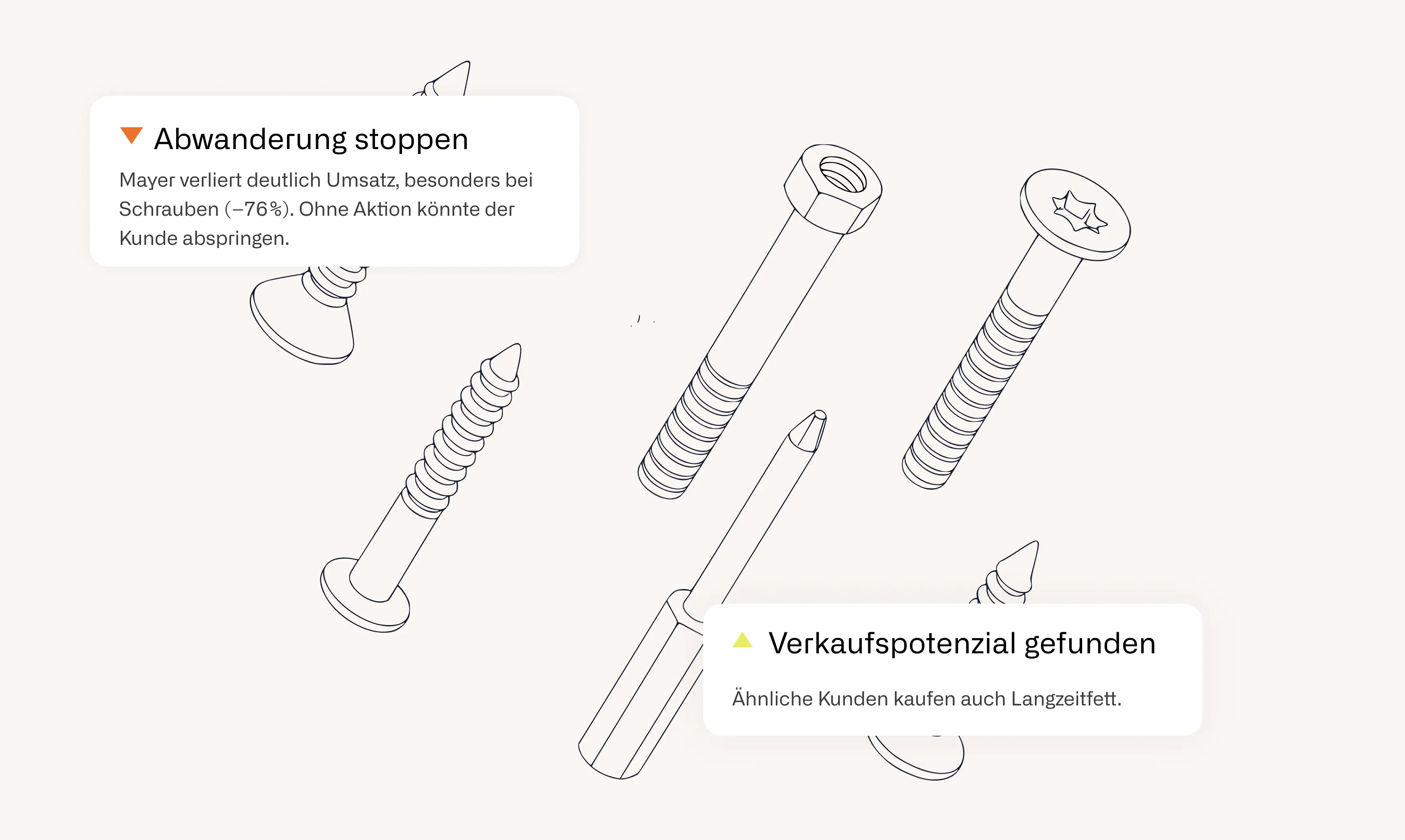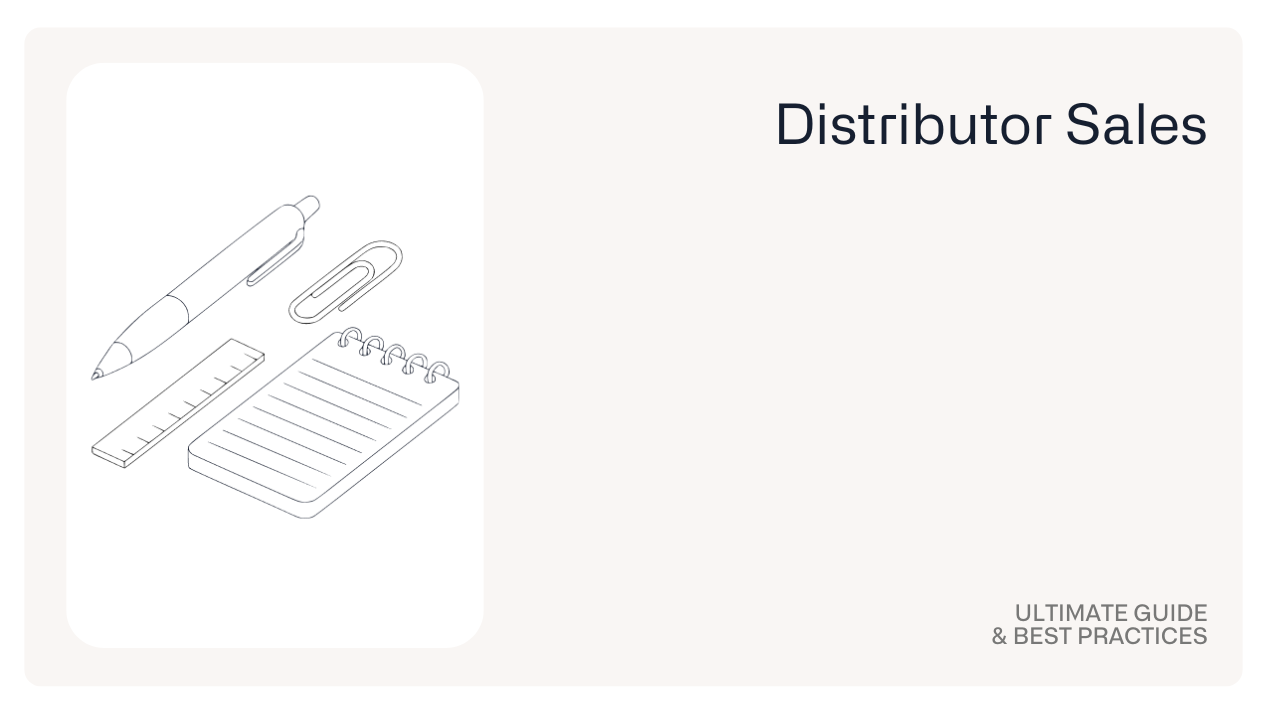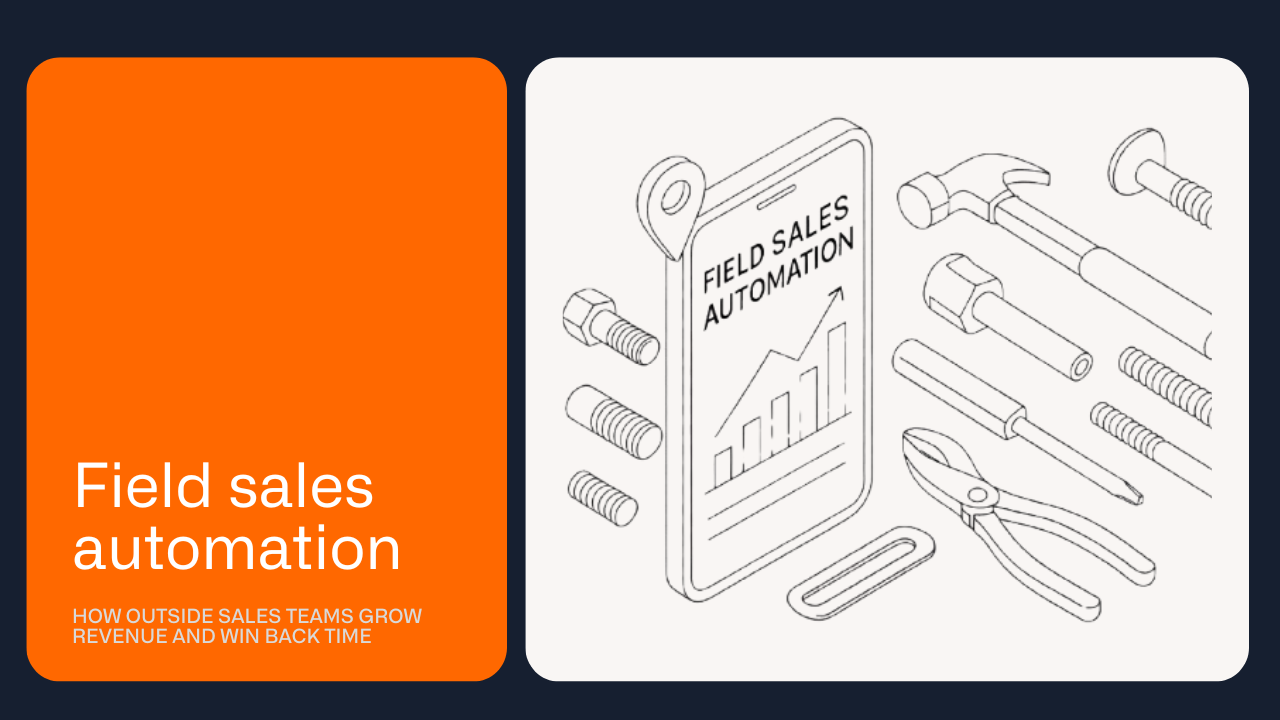Revenue Intelligence in Wholesale: From messy data to concrete action
Summary
Everyone talks about being “data-driven” in sales. But if you ask field reps how they plan their week, you’ll often hear the same thing:
“I look at who I haven’t seen in a while and then just decide on the spot. Honestly, a lot of it is gut feeling.”
That’s not data-driven. That’s damage control. And in wholesale, where margins are thin and competition is fierce, running field sales on gut feel leaves a lot of money on the table.
The truth is simple: wholesalers don’t have a shortage of data. They have a shortage of intelligence.
ERP, CRM, BI dashboards — every system is overflowing with information. What’s missing is the translation into clear actions that sales teams can actually take.
That’s where Revenue Intelligence comes in.
Why Wholesale Is Different (and Harder)
Selling in wholesale is not like selling software or SaaS subscriptions. The challenges are specific and brutal:
- Massive product portfolios. A field rep might be responsible for thousands of SKUs across dozens of categories.
- Huge customer bases. Hundreds, sometimes thousands, of accounts per salesperson.
- Thin margins. Losing one big customer or missing one cross-sell opportunity can erase weeks of hard work.
- Time on the road. Field reps spend hours in the car. Time for “analysis” is practically zero.
The result? Salespeople fall back on habit. They visit the same A-customers, miss signals from B- and C-customers, and often realize churn risks only when it’s too late.
This isn’t laziness. It’s human limitation. No rep can manually track every buying cycle, every anomaly, every dormant customer across 300 accounts and 30,000 SKUs.
Revenue Intelligence solves exactly this gap: turning overwhelming data into specific sales moves, delivered right where the rep works.
What “Revenue Intelligence” Actually Means
There’s a lot of jargon in the market, so let’s strip it down.
Revenue Intelligence = using machine learning to uncover revenue risks and opportunities hidden in sales data, and pushing those insights directly into the daily workflow.
That means answers to practical questions like:
- “Which 10 customers should I prioritize this week?”
- “Which accounts are showing early signs of churn?”
- “Where are untapped cross-sell or upsell opportunities?”
- “What exactly should I prepare for my meeting tomorrow?”
Notice what’s not on that list:
- “Another dashboard to log into.”
- “Another Excel export to check in the evening.”
Revenue Intelligence only works if it’s embedded in the workflow: Outlook, CRM, mobile — the places reps actually live. Otherwise, it’s just BI with better branding.
The Three Big Revenue Leaks in Wholesale
From case studies across wholesale and manufacturing, the same three revenue leaks show up again and again:
- Hidden churn.
Customers don’t stop buying overnight. First, they order less frequently. Then they reduce order size. Finally, they stop. Most reps only notice in the last stage — when the customer is gone. - Missed cross- and upsell.
A customer buys product A regularly but never gets approached for product B. Why? Because the rep didn’t spot the pattern in time. - Time waste on the wrong accounts.
Reps spend hours visiting accounts with little upside while high-potential customers wait. This isn’t bad intent — it’s lack of prioritization.
Together, these three leaks add up to millions in lost revenue. And they are exactly what Revenue Intelligence plugs.
How Revenue Intelligence Works in Practice
Let’s get concrete. This isn’t about futuristic AI dreams — it’s about what wholesale teams are already doing today.
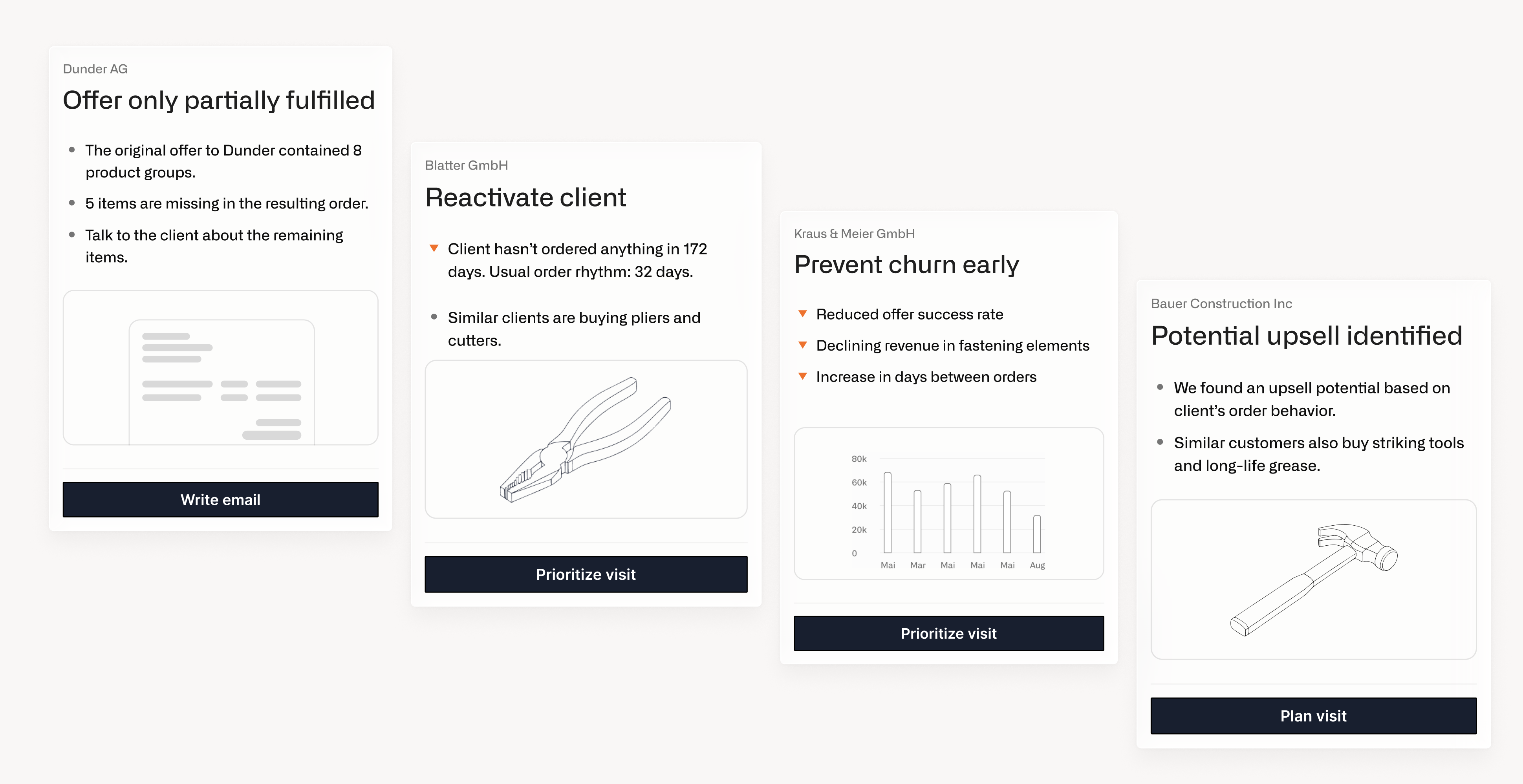
1. Spotting churn before it happens
Machine learning models can detect subtle changes in ordering patterns that humans never see. For example:
- A customer who usually reorders every 30 days is now at day 45 without a purchase.
- Another reduced order volume by 20% compared to their usual average.
For a rep, this shows up not as a dashboard, but as a nudge:
“Customer Weber is overdue for reorder. Call today.”
Schäfer Shop, a large office supplies distributor, ran controlled tests with churn detection like this. Result: +11.2% revenue growth, purely from proactive customer retention.
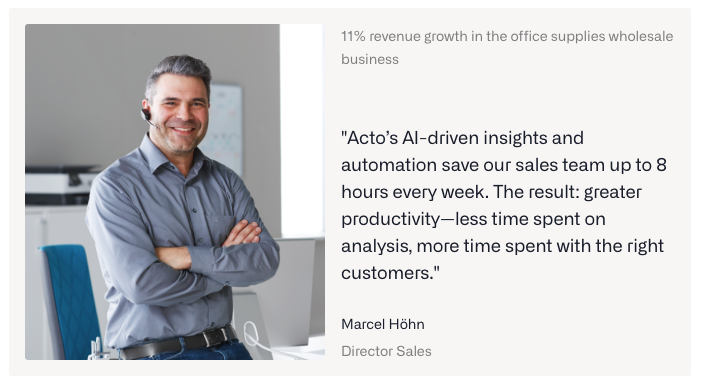
2. Uncovering cross-sell and upsell
Cross-selling in wholesale isn’t obvious. With thousands of SKUs, nobody remembers every logical bundle. Revenue Intelligence does.
Example:
- Customer buys printer cartridges every month but never paper.
- The model knows 70% of similar customers buy both.
- Next time the rep visits, the insight is in their meeting prep:
“Recommend product line B — based on buying pattern.”
At Böllhoff, a manufacturing supplier, this approach drove +8.6% revenue growth, largely by making reps aware of opportunities they previously overlooked.
3. Prioritizing visits with impact
Time is the scarcest resource in field sales. If a rep has 300 accounts, who gets a visit this week? Most decide based on habit — or geography.
Revenue Intelligence flips that. It scores customers by revenue potential, churn risk, and activity — and then ranks them.
Instead of “where the coffee tastes good,” reps get a list like:
- High-risk A-customer → visit first.
- Dormant but high-potential B-customer → reactivate.
- Stable but low-potential account → deprioritize.
Hitado, a medical technology wholesaler, implemented this logic and saw +5.4% revenue growth, without hiring a single extra salesperson.
Why “Embedded” Is the Real Game-Changer
The biggest mistake in wholesale tech is adding “just another tool.” Sales teams already juggle Outlook, CRM, ERP, BI dashboards. Nobody wants another login.
The breakthrough of modern Revenue Intelligence is embedding insights where the rep already works:
- In Outlook: customer emails enriched with churn warnings and upsell suggestions.
- In CRM: accounts flagged by risk and opportunity.
- On mobile: voice briefings during the drive to the next meeting.
That’s why adoption is high. Reps don’t have to change behavior. The intelligence simply meets them in their daily flow.
The Next Frontier: Meeting Prep and Follow-up
Revenue Intelligence doesn’t stop at “who to visit.” It also transforms how those visits happen.
- Preparation: Instead of 45 minutes digging through ERP and CRM, reps get a one-page briefing: last purchases, open offers, churn signals, suggested products. Even read aloud while driving.
- Follow-up: After the meeting, reps dictate notes by voice. Tasks and follow-up emails are generated automatically and synced into CRM.
This removes the two biggest time sinks in field sales: data hunting before meetings and manual documentation afterward.
Getting Started with Revenue Intelligence
Here’s what matters when wholesalers look at implementing Revenue Intelligence:
- Start with your ERP and CRM data. That’s where the gold is — purchase history, order cycles, customer activity.
- Focus on use cases, not features. Ask: do we want to reduce churn, increase cross-sell, or prioritize accounts better? Start there.
- Embed, don’t add. Insights must live in Outlook, CRM, and mobile. If reps need to log into a separate dashboard, adoption will die.
- Prove with pilots. Run A/B tests with a subset of reps. Measure uplift in revenue. Schäfer Shop and others saw double-digit increases this way.
The Competitive Risk of Doing Nothing
Let’s be blunt: ignoring Revenue Intelligence isn’t “safe” — it’s a competitive risk.
- While you’re combing through Excel exports, your competitor is calling the customer that’s about to churn.
- While your reps are making unstructured visits, theirs are visiting exactly the accounts with revenue on the line.
- While your dashboards gather dust, their field team gets daily nudges directly in Outlook.
The difference compounds. Top customers migrate. Upsells are lost. Reps get frustrated. And once competitors start, catching up is twice as hard.
Conclusion: From Gut Feel to Growth
Wholesale sales will always be about relationships. Coffee chats and long-term trust won’t disappear. But relationships without intelligence aren’t enough anymore.
Revenue Intelligence gives field sales teams the edge to keep relationships and grow revenue — systematically, not by chance.
The formula is simple:
- Detect churn before it happens.
- Unlock cross-sell opportunities reps can’t see alone.
- Prioritize time where it creates the most revenue.
- Do it all directly in the tools reps already use.
That’s how wholesalers like Schäfer Shop, Hitado, and Böllhoff are proving: with Revenue Intelligence, you don’t just get more data. You get measurable growth.
Lastest blog posts
Lorem ipsum dolor sit amet, consetetur sadipscing elitr


